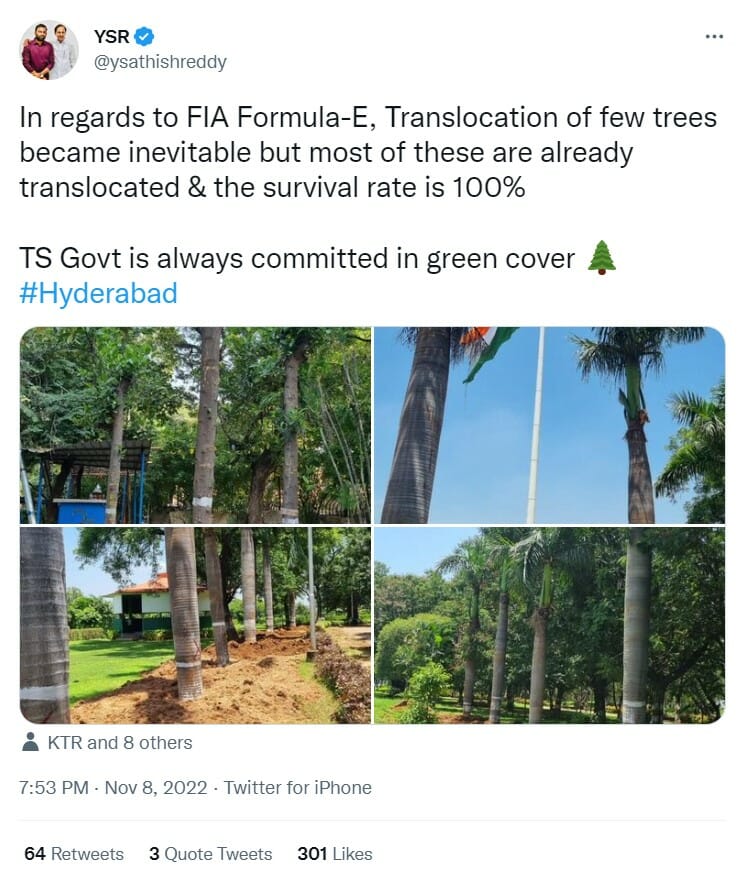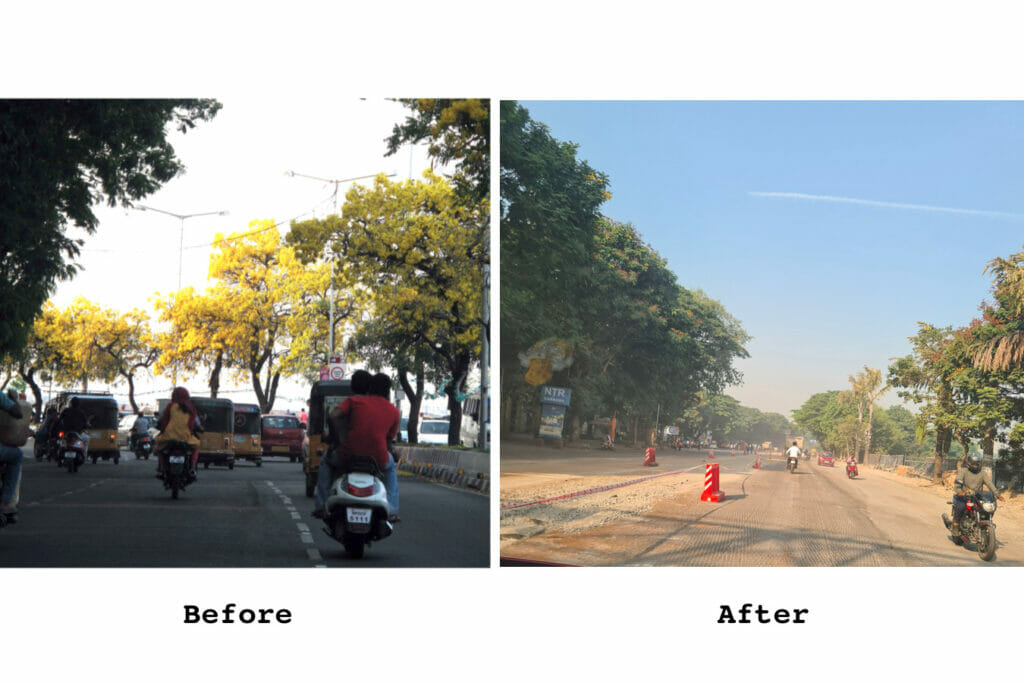Kya kahein kuch kaha nahi jata/ Ab toh chup bhi raha nahi jata. Meer Taqi Meer’s poetry effectively sums up the sentiments of a large number of nature-loving Hyderabadis. More so, after about 200 trees of gold (Tabebuia aurea) and several other trees including pink trumpet trees (Tabebuia impetiginosa) and royal palms were removed from NTR Marg – the road from Secretariat to Khairatabad — to make way for a race track for Formula E races to be held in the city in February 2023.
Formula E is a single-seater motorsport championship conceived in Paris in 2011, to showcase the electrification of the automobile industry and aiming, rather ironically in this case, to reduce carbon-dioxide emissions. The race will be held in Hyderabad on February 10th and 11th, to mark the culmination of the state-organised E-mobility Week, which aims to present the State as an investment destination for the global electric vehicle industry.
The Hyderabad Metropolitan Development Authority (HMDA) is making arrangements for the race, and the trees of gold were presumably removed for the same reason — over two nights, quietly and suddenly. Hyderabadis who had grown to love walking or driving along this stretch received a rude shock in the morning when they saw chopped trunks and branches being carted away in trucks.
Tabebuia aurea is a small tree, ideal for medians. Every year in March and April, these nicely textured trees with gnarled trunks and silver-grey leaves burst into spectacular golden blooms, making the road a visual delight despite the busy traffic. It has been almost 20 years since they had been planted, and year after year they shed their leaves, giving way to the yellow-mustard trumpet-shaped flowers. The name, “tree of gold” comes from this deep, bright yellow of the flowers.
Over the years, Hyderabadis had begun to notice them and would stop to take photos of and with these spectacular rows of trees. This avenue is much loved by many people and was perhaps the only road in the city with so many trees of gold.
Heartbroken citizens
Bengaluru has its avenues of rosy trumpet trees (Tabebuia rosea) that its citizens are proud of and celebrate every year. Our golden trees were Hyderabad’s equivalent of Bengaluru’s pink trumpets and we were ever so proud of this avenue and revelled in their refreshing beauty.
Little wonder then that so many people expressed anguish at this heartless removal of more than 200 fully grown avenue trees.
Beyond sadness and shamelessness…And all done swiftly and suddenly, without any prior indication so that people, the few who care anyway, don’t have the time to mobilise or protest,” said one tree lover .
“Bangaru maargam in Bangaru Telangana destroyed for electric car races”, lamented another. Regular users are heartbroken that the trees of gold that so cheerfully welcomed them during spring would no longer be seen along the avenue.
The rationale behind such a move has eluded everyone here. Citizens have begun to question how the very government which plants and nurtures these trees till they grow and dazzle, simply chop them away to impress the world with a sporting event that is supposed to be eco-friendly.“It is deeply ironic that we are cutting trees – beautiful, fragrant ones! – to host a bunch of electric cars to race near Hussain Sagar. That nobody stopped to see this irony in a state that is keen to press our green credentials forward is exasperating,” said another nature lover.
A senior journalist in the city also rued that local (ecological) destruction for the sake of international attention has become the norm in Hyderabad.
There are of course people who support the tree cutting, and criticise those who expressed dismay and disappointment as being anti-development. They felt that as long as we plant saplings somewhere, it is okay to cut trees that come in the way of our plans.
As media began writing the stories, the government started justifying and defending the decision: the trees were not destroyed, but translocated, with an assurance of 100% survival; there have been huge plantation drives elsewhere in the city; compensatory afforestation has been done. And so on.
But that is really not the point.

All that we’ve lost
The point is that the road that had so many beautiful trees is now bare and lifeless. Hyderabadis, whose commutes were made a little more joyous on that road, will never see these trees or those vibrant flowers again – and that all this displacement is for a race that may last a day or two.
Read more: Is tree transplantation really worth it?
The trees on this avenue took 20 years to grow and bloom in the magnificent way they did. Do they not matter at all? Are they furniture or shamianas that can be moved at the whim and fancy of those with money and power?
Could the racing track not have been planned in any other part of the city? Why is it always either/or when it comes to nature?

In October, Hyderabad won the ‘World Green City Award 2022’ instituted by the International Association of Horticultural Producers, beating 18 cities including Paris, Bogota, Mexico City, Montreal, and Fortaleza in Brazil. A month later, the very same people who took the award, gave permission for the removal of hundreds of fully grown flowering trees in the heart of the city. And it is not the first time this has happened.
The Martyrs’ Memorial that is now under construction replaced a thick wooded area with huge old trees that supported a lot of life. Many trees were removed from the Secretariat compound before construction of the new building began. Recently on the Suchitra-Kompally road, several huge peepal and other trees were pruned mercilessly. Hundreds of heritage banyan trees on the Hyderabad-Chevella road are endangered. The list goes on.
Is Hyderabad adopting a model where our parks become ‘tree ghettos’ with roads and public spaces having only small shrubs and ornamental plants?
A wish list from nature lovers
Trees should not be grown, only to be chopped down in the name of ‘development’. They should be respected, cherished and allowed to live. They create and support rich micro-ecologies that are destroyed when they are cut.
Protection of grown trees should, in all earnest, be made part of Haritha Haram, and not just planting of crores of saplings.
Compensatory planting is not a solution. The original trees served the immediate purpose of ecosystem services and aesthetics where they stood. There’s no substitute for that!
Due importance should be given to natural heritage when any ‘development’ plans are being made, and alternatives sought when large trees are in the way of construction.
It is important to understand that climate change is real and that nature will eventually win over the human-made world. Recognise the various kinds of native vegetation in the State and preserve it.
Retain the character of our landscapes in our roads, towns and cities. Hyderabad should genuinely cherish, protect and justify the tag, “Green City”.